OnePlus has a knack for making flagship-killer phones at an affordable price point. The company’s latest, however, the OnePlus 7 Pro, comes in at a comparable cost to the Galaxy S10 Plus.
So, what’s the better deal: Samsung’s ultra-premium Galaxy
Specs
| OnePlus 7 Pro | Samsung Galaxy S10 Plus | |
| Size | 162.6 × 75.9 × 8.8 mm (6.4 × 2.98 × 0.34 inches) | 157.6 × 74.1 × 7.8 mm (6.20 × 2.91 × 0.30 inches) |
| Weight | 206 grams (7.26 oz) | 175 grams (6.17 ounces) |
| Screen size | 6.67-inch Fluid AMOLED | 6.4-inch Dynamic AMOLED |
| Screen resolution | 3,120 × 1,440 pixels (516 pixels per inch) | 3,040 × 1,440 pixels (526 pixels per inch) |
| Operating system | Android 9.0 Pie (under Oxygen OS) | Android 9.0 Pie (under One UI) |
| Storage space | ||
| MicroSD card slot | No | Yes, up to 512GB |
| Tap-to-pay services | Google Pay | Google Pay, Samsung Pay |
| Processor | Qualcomm Snapdragon 855 | Qualcomm Snapdragon 855 |
| RAM | 6GB, 8GB, 12GB | 8GB, 12GB |
| Camera | Triple lens 48-megapixel, 16MP ultra-wide angle, and 8MP telephoto rear, 16MP front | Triple lens 16-megapixel ultra wide-angle, 12MP variable aperture, and 12MP telephoto rear, 10MP, and 8MP front dual lens |
| Video | 2,160p at 60 fps, 1,080p at 240 fps, 720p at 480 fps | 2,160p at 60 fps, 1080p at 240 fps, 720p at 960 fps |
| Bluetooth version | Bluetooth 5.0 | Bluetooth 5.0 |
| Ports | USB-C | 3.5mm headphone jack, USB-C |
| Fingerprint sensor | Yes, in-display | Yes, ultrasonic in-display |
| Water resistance | No | IP68 |
| Battery | 4,000mAh
Fast charging (Warp)
|
4,100mAh
Fast charging (QuickCharge 2.0) Qi wireless charging |
| App marketplace | Google Play Store | Google Play Store |
| Network support | T-Mobile, AT&T, Verizon, Sprint | T-Mobile, AT&T, Verizon, Sprint |
| Colors | Mirror gray, nebula blue, almond | Prism black, prism white, prism blue, flamingo pink, ceramic black, ceramic white |
| Price | $669 | $1,000 |
| Buy from | OnePlus | Samsung, Amazon |
| Review score | 4 out of 5 stars | 4.5 out of 5 stars |
Performance, battery life, and charging

Both these phones come with Qualcomm’s Snapdragon 855 processor inside, so you can expect extremely fast performance and neither will have any issues running demanding games or apps. You have a choice of 6GB, 8GB, or 12GB of RAM with the OnePlus 7 Pro, while the
The
Winner: Samsung Galaxy
Design and durability
These are two of the best-looking phones on the market right now with curved glass front and back, a beautiful build quality, and almost all-screen fronts. Samsung chose to go with a hole-punch camera for its dual-lens front-facing shooter, which sits at the top right of the screen. OnePlus has opted to go with a pop-up selfie camera instead, which means the enormous screen is free of notches or holes. These are both big phones, but the
On the back, there’s a horizontal camera module for the
While the OnePlus 7 Pro lacks an IP rating, the
Winner: Samsung Galaxy
Display
The OnePlus 7 Pro boasts a 6.67-inch AMOLED screen with a resolution of 3,120 x 1,440 pixels, which is 516 pixels per inch (ppi). The Samsung Galaxy
Winner: Tie
Camera

The OnePlus 7 Pro has the first triple-lens camera we’ve seen in a OnePlus phone. There’s a 16-megapixel ultra-wide lens with a 117-degree field of view, a 48-megapixel lens with optical and electronic image stabilization (OIS and EIS), and an 8-megapixel telephoto lens for a 3x optical zoom or a 10x digital zoom. The Samsung Galaxy
Around front, the OnePlus 7 Pro has that pop-up 16-megapixel selfie camera, but the dual-lens front-facing camera in the
Winner: Samsung Galaxy
Software and updates

While both these phones have Android 9.0 Pie on board, they have different skins on top. We like Samsung’s polished One UI and it offers quite a lot of extra functionality. Oxygen OS on the OnePlus 7 Pro is closer to Google’s flavor of
Winner: OnePlus 7 Pro
Special features

The
Winner: Samsung Galaxy
Price and availability
The OnePlus 7 Pro starts from $670 for 128GB of storage and 6GB of
The Samsung Galaxy
Overall winner: Samsung Galaxy S10 Plus
Given the choice we would certainly take the Samsung Galaxy
Editors' Recommendations
- Have a Samsung Galaxy S23? Don’t update your phone to One UI 6.1
- The best Android phones in 2024: the 14 best ones you can buy
- Don’t buy a Galaxy S24 Ultra or iPhone 15 Pro Max. Do this instead
- The 10 accessories you need for your Samsung Galaxy S24
- The best Samsung Galaxy S24 Plus screen protectors: top 8 picks





